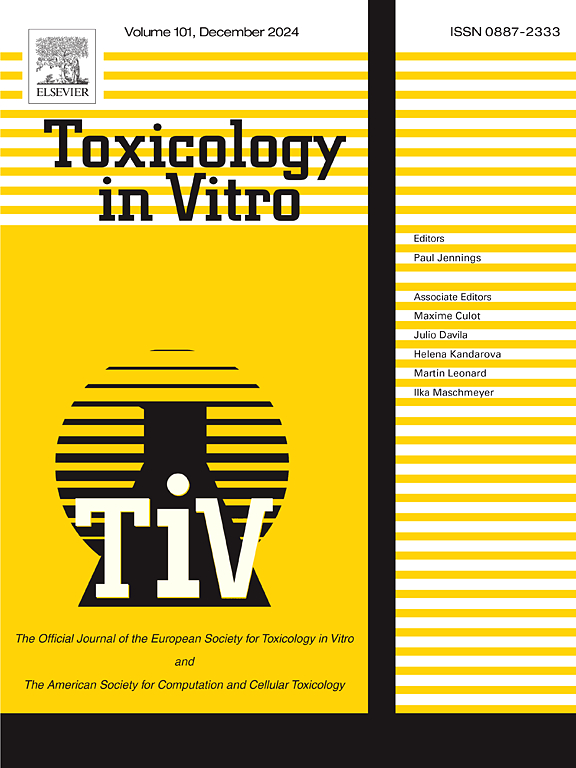Predictive classification-based read-across for diverse functional vitiligo-linked chemical exposomes (ViCE): A new approach for the assessment of chemical safety for the vitiligo disease in humans
IF 2.6
3区 医学
Q3 TOXICOLOGY
引用次数: 0
Abstract
We have explored a new approach using a similarity measure-based read-across derived hypothesis to address the precise risk assessment of vitiligo active chemicals. In this analysis, we initially prepared a data set by combining vitiligo active compounds taken from the previous literature with non-vitiligo chemicals, which are non-skin sensitizers reported in another literature. Afterward, we performed the manual curation process to obtain a curated dataset. Furthermore, the optimum similarity measure was identified from a validation set using a pool of 47 descriptors from the analysis of the most discriminating features. The identified optimum similarity measure (i.e., Euclidean distance-based similarity along with seven close source compounds) has been utilized in the read-across derived similarity-based classification studies on close source congeners concerning target compounds. In this study, we identified the positive and negative contributing features toward the assessment of vitiligo potential as well, including the estimation of target chemicals with better accuracy. The applicability domain status of the reported compounds was also studied, and the outliers were identified. As there are no comparative studies in this regard to the best of our knowledge, we can further affirm that it is the first report on the in-silico identification of potential vitiligo-linked chemical exposomes (ViCE) based on the similarity measure of the read-across.

基于预测分类的多种功能性白癜风相关化学暴露体(ViCE)的跨读:一种评估人类白癜风疾病化学品安全性的新方法。
我们探索了一种新的方法,使用基于相似性测量的跨读衍生假设来解决白癜风活性化学物质的精确风险评估。在本分析中,我们最初通过将从先前文献中提取的白癜风活性化合物与非白癜风化学物质(另一文献中报道的非皮肤致敏剂)结合起来开发了一个数据集。之后,我们执行手动策展过程以获得一个策展的数据集。此外,使用来自最具区别性的特征分析的47个描述符池,从验证集中确定了最佳相似性度量。所确定的最优相似性度量(即基于欧几里得距离的相似性与7个近源化合物)已被用于对目标化合物的近源同源物的跨读衍生相似性分类研究。在这项研究中,我们确定了白癜风潜在评估的积极和消极贡献特征,包括对目标化学物质的估计具有更好的准确性。研究了所报道化合物的适用域状态,并确定了异常值。据我们所知,在这方面还没有比较研究,我们可以进一步肯定,这是第一份基于读通相似性测量的潜在白癜风相关化学暴露体(ViCE)的计算机识别报告。
本文章由计算机程序翻译,如有差异,请以英文原文为准。
求助全文
约1分钟内获得全文
求助全文
来源期刊

Toxicology in Vitro
医学-毒理学
CiteScore
6.50
自引率
3.10%
发文量
181
审稿时长
65 days
期刊介绍:
Toxicology in Vitro publishes original research papers and reviews on the application and use of in vitro systems for assessing or predicting the toxic effects of chemicals and elucidating their mechanisms of action. These in vitro techniques include utilizing cell or tissue cultures, isolated cells, tissue slices, subcellular fractions, transgenic cell cultures, and cells from transgenic organisms, as well as in silico modelling. The Journal will focus on investigations that involve the development and validation of new in vitro methods, e.g. for prediction of toxic effects based on traditional and in silico modelling; on the use of methods in high-throughput toxicology and pharmacology; elucidation of mechanisms of toxic action; the application of genomics, transcriptomics and proteomics in toxicology, as well as on comparative studies that characterise the relationship between in vitro and in vivo findings. The Journal strongly encourages the submission of manuscripts that focus on the development of in vitro methods, their practical applications and regulatory use (e.g. in the areas of food components cosmetics, pharmaceuticals, pesticides, and industrial chemicals). Toxicology in Vitro discourages papers that record reporting on toxicological effects from materials, such as plant extracts or herbal medicines, that have not been chemically characterized.
 求助内容:
求助内容: 应助结果提醒方式:
应助结果提醒方式:


